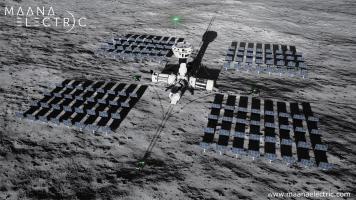This activity aimed to develop a first concept of plug and socket that can withstand the harsh operational conditions that are posed by the lunar environment (vacuum, radiations, high thermal gradients) and by the contamination of very fine and abrasive regolith without affecting the long-term product performance.
Under this Discovery element contract, Maana Electric investigated on the technical solutions that could be implemented into the lunar plug and socket system, such as a list of specific materials and dust mitigation strategies. Commercial off-the-shelf connectors, designed for high performances under challenging environments have been also used as a reference. The selection of the elements that best fitted for lunar application have been carried out by performing appropriate trade-off studies. In order to validate the results of the trade-offs, a Proof of Concept testing campaign was carried out and the outcome was used to design a plug and socket system that could sustain 150V at 50A, which is compatible with the expected user scenario with photovoltaic arrays providing power to first permanent lunar habitats.
To develop large scale infrastructure on the Moon many different systems will have to be shipped to the Moon to produce the necessary components. This means that the traditional design of systems cannot be assumed and a production machine cannot be expected to provide its own power especially when power demand is in the 100kW-1MW range . A large scale lunar or martian base will most likely require an operating micro grid network, in order to effectively progress large scale developments. With this comes one key complexity, which is the interconnection of systems that require power with the systems producing power. On Earth this has been solved with standardized plugs and sockets which are used for an electrical load to be connected to a generation source. Even on Earth however, many standards exist depending mainly on geography. In space it is even less desirable to have many different plugs as this will increase mass, cost and operational complexity. Therefore a truly standardized plug and socket solution for surface operations on the Moon and Mars is desirable. More important even is that a solution should be designed for the operating environment, taking into consideration aspects such as the dust issues, temperature swings, and the users of the plug. Will astronauts utilize the plug or will it be robotic systems? Maana Electric is specifically focused on the generation side of electricity on other celestial bodies using ISRU produced solar panels. One of the major issues identified in developing this concept is the interconnection of such solar panels with each other, the local grid and electrical loads. The concept has been discussed with other companies, and it has been identified as a general issue which the space industry will face as it moves into large scale infrastructure development on the Moon and Mars. Maana would like to take the initiative in developing the plug and socket of the future and setting the standard for operations on the Moon and Mars.

